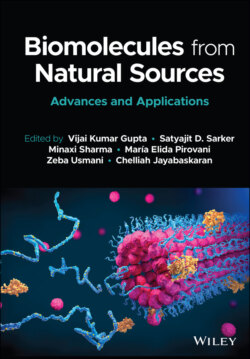Читать книгу Biomolecules from Natural Sources - Группа авторов - Страница 42
2.1.8 The Eight Different Biopolymers
ОглавлениеThe eight types of biopolymers are: (1) nucleic acids (DNA and RNA); (2) polyamides which are polymers containing repeated amide groups (protein poly-(amino acids) such as, gelatine, casein, wheat gluten, silk and wool); (3) polysaccharides, any of a class of carbohydrates whose molecules contain chains of monosaccharide molecules (such as, starch, cellulose, lignin, chitin); (4) organic polyoxoesters (such as poly(hydroxyalkanoic acids), poly(malic acid) and cutin); (5) polyisoprenoides (such as natural rubber or gutta-percha [a whitish rubber derived from the coagulated milky latex of gutta-percha trees; used for insulation of electrical cables]); (6) inorganic polymers such as inorganic polyesters with polyphosphate, (7) polyphenols (such as lignin or humic acids), and (8) polythioesters, for example, poly(3-mercaptopropionate). Polymers from bioderived monomers could be polymerized and might be added as group nine. Additionally, some inorganic elements might show accumulation in the microbial cells in repeated forms but due to their nature they form crystals which are usually different to those made in labs. For example, magnetotactic bacteria show Fe3O4 chains of similar crystals which are unique in their structures. The helical twist of the Fe3O4 series of crystals are not cubes. It might be interesting to report that similar structures are found in goethite in the strengthening of limpet teeth. Other examples are iron, sulphides, pyrite crystals found in some anaerobic bacteria. In fact, more research should be conducted on the nature of the inorganic structures which might be finally classified as biopolymer because they are not crystalline spontaneously but due to the effect of proteins and enzymes. The amazing structure of different diatoms might be a good example [35, 38, 39].
